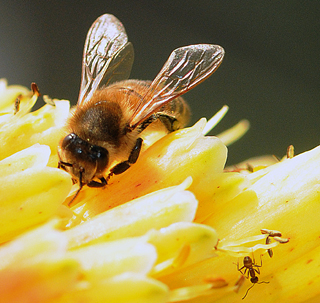The tool automatically detects and identifies the most dangerous actors or nodes within a given social network and the density of the interconnected relationships between them, which may help law enforcement authorities make their decisions and act in the most efficient way possible.
Bees have a fairly simple social system: scouts look for food sources; worker bees collect food; and supervisor bees are in the colony. Data exchange and communication processes are established between those three roles, what makes the overall performance of the colony very profitable. Dismantling that is fairly simple. The classic (and also the most natural and intuitive) method for dismantling a network is to identify its main actors and take action on them. However, this strategy does not ensure that the resulting network is totally devoid of organizational and reconstructive power, and it may continue to cause harm.

Bees and ants and social networks. Credit: UC Davis
The results of the experiments indicate that the new proposed technique significantly improves, from a statistical point of view, the classic strategy used for attacking and dismantling social networks.
As the authors explain, “the subtlety with which groups or colonies of relatively simple living beings (ants, termites, bees, etc.) are able to solve vital problems to survive is a proof of the effectiveness of evolution”.
By means of certain interrelationships among the members of a colony, a collective behavior emerges from that colony, and it allows them to efficiently react to problematic environmental situations, which would be possible for one bee alone.
“In order to achieve the most effective way of dismantling a network it is necessary to develop and put into action an optimization process that analyzes a multitude of situations and selects the best option in the shortest time possible. It’s something similar to what a chess program does when identifying, predicting and checking the possible steps or paths that may occur in a game of chess from a given moment and movement,” they write.
Citation: Manuel Lozano, Carlos García-Martínez, Francisco J. Rodríguez, Humberto M. Trujillo, 'Optimizing network attacks by artificial bee colony', Information Sciences Volume 377, 20 January 2017, Pages 30–50






Comments